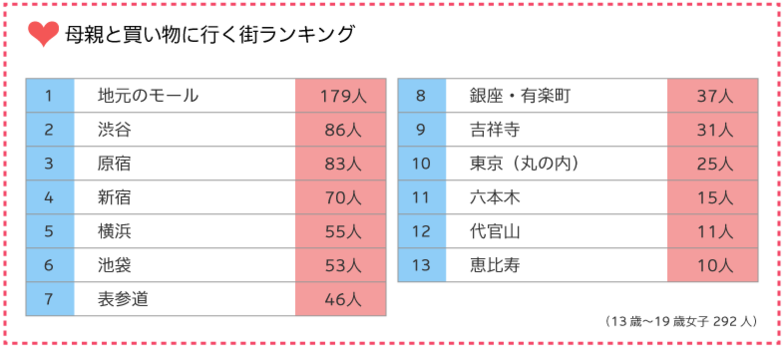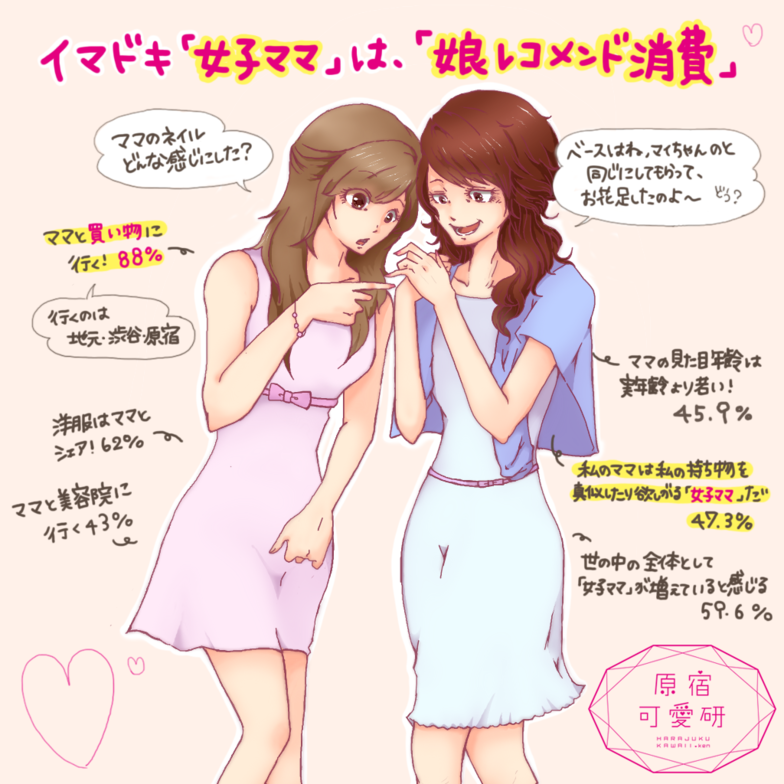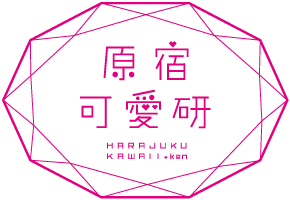❤More Young Moms!?
── "Moms choose clothes that are youthful, like 'Barbie' stuff. They look young too. They're aware of their own beauty and often ask, 'Who's prettier?' (High school freshman)
There was a song about always feeling 17, but today's moms seem young not just at heart, but in appearance too. According to research by Harajuku Kawaii Ken, 72% of teenage girls feel that "there are more mothers who look younger these days."
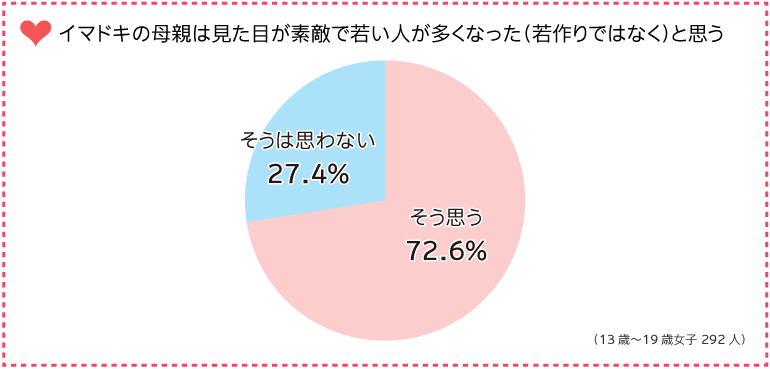
Incidentally, about half (45.9%) of teenage girls said their own mothers "look younger than their actual age." This feeling persists even as their mothers age, and the percentage actually increases.
・Mother is in her 30s, looks like she's in her 20s = 40%
・Mother is in her 40s, looks like she's in her 30s = 37%
・Mother is in her 50s, looks like she's in her 40s = 47%
When discussing the factors behind the rise in ageless, youthful mothers, the topic of women's increased participation in the workforce since the implementation of the Equal Employment Opportunity Act cannot be overlooked. As the number of working women increases year by year and their desire to work grows stronger, family structures have diversified, and the number of so-called "housewives" continues to decline. The average age of first-time mothers is rising, the unmarried rate is steadily increasing, and there is no longer a set timeline for marriage and childbirth.
As a result, women no longer necessarily marry in their late twenties, leave their jobs to become mothers, and settle into traditional roles. Even when they do become mothers themselves, they are often influenced by peers who delay marriage or continue working, making it harder to follow a set path. With women's life stages no longer following a uniform trajectory, the moment when women "graduate" from being "modern girls" has effectively disappeared.
The notion of what is appropriate for a certain age has vanished, so women no longer worry about "what I should be doing at my age." They now choose the clothes and hairstyles they like. Against this backdrop, the sense of style and appearance of women in the mother generation has changed dramatically.
Consider the famous manga Sazae-san: when it began serialization in 1946, the initial setting for Mrs. Isono Fune was 48 years old. If we think of 48-year-olds today, in 2015, people like Towa Kimijima or Yu Hayami might help illustrate that change.
The era where "women past 25 were like Christmas cakes" and "marriage and childbirth in your late 20s were the norm" has passed. We've now entered a time where it's simply accepted that women remain active participants in life, regardless of whether their life stages change or not.
❤ "Girl Mom" – Moms fascinated by young girls' possessions, and "Daughter-Recommended Consumption"
As mothers' sense of style and appearance have become more youthful, more moms are becoming interested in the cosmetics, clothes, and accessories used by their fashion-conscious daughters. They want to use them too, imitating their daughters and desiring their possessions.
Dentsu Inc. Gal Lab refers to these mothers as "Girl Moms." They call this consumption behavior "Daughter-Recommended Consumption" (*).
※Recommendation... originally a business term referring to analyzing a specific customer's registration information and purchase history to analyze preferences and recommend products. As services rapidly spread, it has recently become more common in everyday conversation. Also spelled "recommend."
Surveys show that nearly half (47.3%) of teenage girls agree their own mothers fit the "girl mom" description. Sixty percent of daughters feel this "girl momification" of their mothers is a growing trend across society. This suggests that capturing the hearts of young daughters is increasingly likely to mean capturing the hearts of both daughters and their mothers.
We asked high school girls what products they thought their mothers had recently purchased that were aimed at younger generations.
Besides keeping up with the latest trends like "selfie sticks" (*), they also buy "mobile phone accessories" identical to their daughters'. They seem to check "magazines" too.
※Selfie stick: A stick-shaped tool that attaches to a smartphone for taking selfies. "Selfie" is an abbreviation of "self-camera," meaning a photo taken by oneself, and is one example of Konglish (Korean-influenced English). Invented in Japan in the 1980s, it failed to catch on and was mocked as a "bizarre Japanese invention." However, amid the global selfie boom, it became a worldwide hit product in 2014.
They also actively incorporate the latest cosmetics their daughters use, such as "colored contacts," "nail products, extensions, and false eyelashes." And the most frequently mentioned items in the responses were, unsurprisingly, fashion accessories. "Detachable collars(※)," "skirts with ribbons," "cute hair accessories," "pink shoes," "clothes, bags, pretty much everything I buy!"
*Detachable collars are fashion items that attach only to the neckline of dresses or tops, and have been popular for several years now. They're convenient because they let you create a look with a visible collar without layering. Standard types include simple white shirt collars, lace collars, and those with pearls or jewels, but variations have increased recently, with items like turtleneck-style "detachable turtlenecks" also appearing.
❤Moms and daughters sharing clothes is totally normal! Top brands moms and daughters share
As mothers have become more interested in their daughters' clothes, more mother-daughter pairs are sharing outfits.
── "We share absolutely everything! Actually, Mom just takes my clothes without asking." (High School Freshman)
── "When shopping with Mom, she buys clothes we can share. I get affordable fast fashion pieces to mix and match, so we often use them together." (High School Freshman)
According to research by Harajuku Kawaii Ken, 62.3% of teenage girls share clothes with their mothers, making them the majority. What's more, it's not just basic brands or adult-oriented brands that seem perfect for sharing with moms—it's increasingly common for them to buy brands found in youth-oriented fashion buildings in Shibuya and Harajuku. That's the modern mom-daughter dynamic. So this time, we asked what brands, besides the so-called basic ones, are being chosen by moms and daughters.
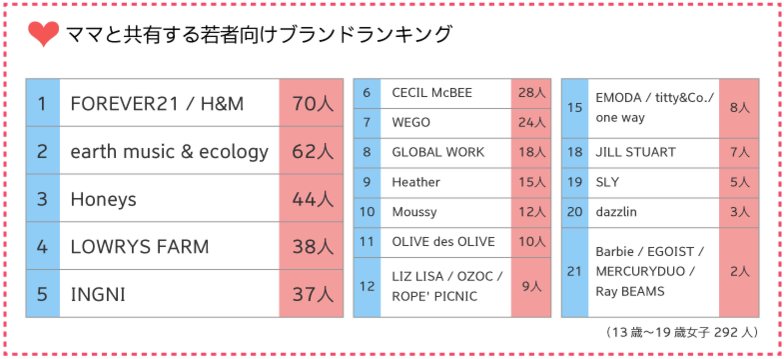
The fact that brands strongly associated with being popular among teenage girls also rank highly shows that mothers' clothing styles are becoming younger.
❤Moms and daughters shop together in Shibuya and Harajuku. They also go to the salon and nail shops together.
Naturally, opportunities to go out with their mothers have also increased.
While the trend of many mother-daughter pairs shopping together (88%) hasn't changed much over time, what defines modern mother-daughter relationships is that they now go together not just shopping, but also to the hair salon (43%), as well as other places like massage therapists, estheticians, eyelash extensions, and nail salons – places where going with your mother would have been unthinkable just a generation ago.
Also, when it comes to shopping destinations, you might expect places like Omotesando or Ginza—areas with a more adult image—to be popular besides their hometowns. But it seems the current trend is to choose Shibuya and Harajuku, areas strongly associated with youth culture.
❤High School Girls' Perspective on Mom Style: Where "Cool" Meets "Awkward"
── "I think it's stylish when moms wear clothes that even high schoolers could pull off!" (12th grader)
── "My mom rocks knee-high socks too." (9th grader)
── "I saw a mom who looked super cool in a shocking pink coat with all black underneath." (9th grader)
── "Moms who have cute nail polish or look stylish no matter what they wear are awesome." ( High School Freshman)
── "My friend's mom is gorgeous. She's a beauty queen, like a magical beauty." ( High School Sophomore)
Moms who look young and have youthful style are the envy of high school girls.
However, during interviews, we discovered that even among young-looking mothers, some are perceived as "embarrassing" by high school girls.
While they generally view positively mothers who incorporate clothing and items from their own generation, there seem to be three major points they find unacceptable: "exposure," "childishness," and "TPO."
Where exactly is the line between what's motherly and what isn't? That boundary seems heavily influenced by the sensibilities of the times, making a clear demarcation impossible. After all, stereotypes like "this is what you should do at this age" are fading anyway, so it's probably only natural.
That's precisely why the information trend-savvy daughters possess, and their candid feedback, is invaluable to mothers. Perhaps this is why mothers and daughters now share and exchange information on everything—fashion, beauty, possessions.
This holds true across generations: many women, when raising children, avoid repeating things they disliked as children and instead want to emulate what made them happy. High school girls like mothers who are young and treat them like friends. That's why they aspire to become mothers like that someday.





